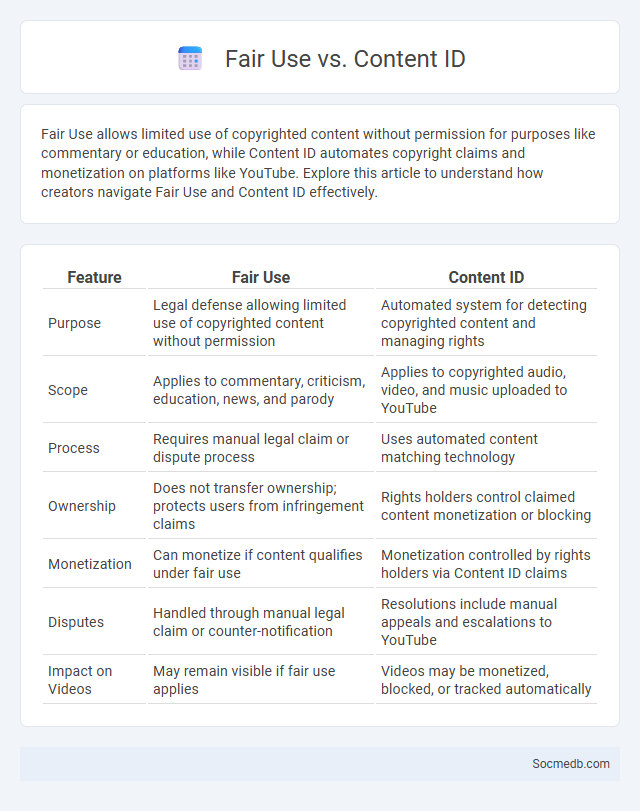
Photo illustration: Fair Use vs Content ID
Fair Use allows limited use of copyrighted content without permission for purposes like commentary or education, while Content ID automates copyright claims and monetization on platforms like YouTube. Explore this article to understand how creators navigate Fair Use and Content ID effectively.
Table of Comparison
| Feature | Fair Use | Content ID |
|---|---|---|
| Purpose | Legal defense allowing limited use of copyrighted content without permission | Automated system for detecting copyrighted content and managing rights |
| Scope | Applies to commentary, criticism, education, news, and parody | Applies to copyrighted audio, video, and music uploaded to YouTube |
| Process | Requires manual legal claim or dispute process | Uses automated content matching technology |
| Ownership | Does not transfer ownership; protects users from infringement claims | Rights holders control claimed content monetization or blocking |
| Monetization | Can monetize if content qualifies under fair use | Monetization controlled by rights holders via Content ID claims |
| Disputes | Handled through manual legal claim or counter-notification | Resolutions include manual appeals and escalations to YouTube |
| Impact on Videos | May remain visible if fair use applies | Videos may be monetized, blocked, or tracked automatically |
Understanding Copyright: The Basics
Understanding copyright in social media is essential to protect your original content from unauthorized use and avoid legal issues. Copyright laws grant creators exclusive rights to reproduce, distribute, and display their work, including images, videos, and text shared online. Ensuring you respect others' copyrights by obtaining permission or using licensed materials safeguards your social media presence and maintains ethical standards.
What is Fair Use?
Fair Use allows you to legally use copyrighted content on social media without permission under specific conditions such as commentary, criticism, news reporting, teaching, or research. It balances the rights of content creators with public interest by considering factors like the purpose, nature, amount, and effect of the use on the original work's value. Understanding Fair Use helps protect your social media posts from copyright claims while respecting intellectual property laws.
How Fair Use Applies to Online Content
Fair use in social media governs the limited use of copyrighted content without permission, typically for purposes such as commentary, criticism, news reporting, or educational use. Platforms like YouTube and Instagram implement algorithms and policies to identify potential copyright infringements while allowing transformative content that adds new meaning or value. Understanding fair use principles helps creators navigate legal boundaries when sharing memes, videos, or images, balancing content protection with creative freedom.
Introduction to Content ID
Content ID is a powerful tool designed to help creators manage their copyrighted material on social media platforms by automatically identifying and monetizing unauthorized uses of their content. Your videos, music, or images are scanned against a vast database to detect matches, ensuring that your intellectual property rights are protected. This system enables you to control how your content is shared, either by blocking, tracking, or monetizing it across various social media channels.
How Content ID Detects Copyrighted Material
Content ID uses advanced audio and video fingerprinting algorithms to scan videos uploaded on platforms like YouTube, matching them against a vast database of copyrighted material submitted by rights holders. When a match is detected, the system flags the content for actions such as monetization, blocking, or tracking, depending on the copyright owner's preferences. This automated process enables efficient copyright enforcement by identifying unauthorized use without manual review.
Fair Use vs Content ID: Key Differences
Fair Use allows creators to use copyrighted content under specific conditions like commentary, criticism, or education without permission, whereas Content ID is an automated system by platforms like YouTube that scans uploaded videos for copyrighted material and enforces rights through monetization or removal. Content ID decisions are based on algorithmic matches, often leading to disputes when fair use claims are involved, requiring manual review and appeals. Understanding these key differences is crucial for navigating copyright issues on social media effectively.
Common Fair Use Myths Debunked
Common fair use myths often mislead many social media users about what content they can legally share or modify. You might assume that all content on social media is free to use, but fair use laws allow limited use only for purposes like commentary, criticism, or educational use. Understanding the true scope of fair use helps protect your content from copyright infringement claims while encouraging responsible sharing.
Challenges Creators Face with Content ID
Content creators face significant challenges with Content ID systems, including frequent disputes over copyright claims that can lead to demonetization or removal of their content. The automated nature of these systems often results in false positives, impacting creators' revenue streams and audience reach. Navigating complex appeal processes and inconsistent enforcement further complicates content management and intellectual property protection for creators.
Resolving Content ID Disputes Under Fair Use Claims
Resolving Content ID disputes under fair use claims requires precise evidence demonstrating transformative use, non-commercial intent, or educational purpose to strengthen your argument. You should provide clear context and documentation supporting how your use falls within fair use parameters to expedite resolution. Effective communication with the platform's dispute process increases the likelihood of reclaiming content and avoiding wrongful takedowns.
Tips for Navigating Fair Use and Content ID Safely
Navigating fair use and Content ID on social media requires understanding copyright laws and how platforms detect protected content. You should always evaluate the purpose, nature, amount, and effect of your content to determine fair use eligibility and avoid automatic Content ID claims. Using original content, obtaining proper licenses, and leveraging platform-specific tools can help protect your videos while respecting creators' rights.
 socmedb.com
socmedb.com